
- CONTROLLING THE CORNERS

- Classic Performance Products has a new sway
bar kit for
- 1963-72 Chevy trucks that will give your old
truck new character
-
- By Brian McCormick
|
Some of you 1963-72 Chevy truck owners may or may not
know it, but the suspension under your truck is actually one of the finest
engineered designs ever created for a truck. The rear sports a lanky pair
of ladder bars, a symbol of traditional GM design in the '60s with progressive
two-stage coil springs mounted in front of the rear axle for a smooth, yet
very stable ride. The basic design of the rear suspension is so successful,
take a peek under a Winston Cup stock car sometime and see just how similar
its setup is to your stock suspension. Up front, Chevrolet gave its trucks
a great independent front suspension which utilizes an upper and lower control
arm with a coil spring centrally located in a frame pocket, and externally
mounted shocks that extend from the lower control arm to the frame.
This too is a very well designed suspension that is again very similar in
the basic concept to what you would find under a Winston Cup stock car.
Of course, all those technical coil spring rates, shock pressure valving
and tire pressures make a stock car's handling characteristics change dramatically
depending upon which way the mechanic turns the wrench or which
|
spring is installed. It's not in our best interest to
always be wrenching on our truck's chassis or changing spring rates once
a week, so what do we do to gain an edge on performance handling since we
already have a suspension that can be made to stick to any road? The
best way to gather up the banking and rip through a corner like one of stock
car racing's finest is to install a very economical sway bar. The sway bar
is like the backbone to a well performing suspension. It acts as another
valuable chassis tuning tool for stock car mechanics, while it provides
a very affordable means of installing performance for street use.
Now, providing that your truck doesn't have a sway bar (since many
of the trucks of the 1963-72 era didn't come equipped with such accessories),
you are probably well aware of what happens when you attempt to take your
truck into a corner at any speed. Like myself, I'm sure that
you feel like you're going to fall out of the side window. Well my
Chevy friends, that is no more if you install one of Classic Performance
Products' new high-performance sway bars on your truck. Your truck will
be transformed into a totally different vehicle as you attempt a hard
|
banking corner and find that your truck wants to rocket
forward while remaining laterally efficient to the road surface, forcing
your suspension to work properly. The difference is like night and
day. You will even notice that your suspension will react slightly
more sporty simply driving down a straight road. Bumps, dips and small potholes
seem to be absorbed better by the suspension with anew sway bar. The
Classic Performance Products' sway bar is thicker than any of the stock
units produced in this time period with an overall diameter of 1.25 inches,
and is constructed from high carbon steel. Using the stock holes in the
control arm, end links with methane bushings are installed to position the
sway bar to work more efficiently than if it is mounted straight to the
control arm. Frame mounting brackets are also provided in the kit
and use the factory holes, two of which must have the factory rivets removed
at the crossmember prior to the installation. From start to finish, it took
one installer only twenty minutes to install the C.P.P. sway bar kit. Did
it ever make a difference! For the money, this is the best suspension mod
you can make to your truck before getting high-tech.
|
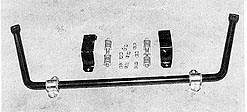
The Classic Performance Products kit comes complete with
a heavy-duty 1.25-inch sway bar, urethane bushings, end links, frame mounting
brackets and grade-eight hardware.
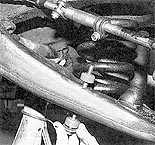
After you have jacked the truck up and properly supported
it with jack-stands, begin by installing the end link through the factory
hole in the control arm as shown.
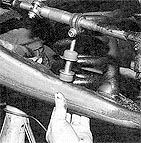
Holding the end link up, install a urethane bushing first,
then a washer, then the end link steel bushing, then a washer, and finally,
another urethane bushing. If your truck is exceptionally low, the tie-rod
end adjusters on both sides may rub against the sway bar. You can cut the
steel bushing in half or remove it altogether, whichever better solves the
problem for you.
|
|
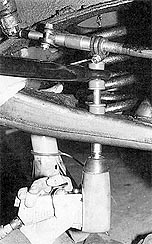
Once you have determined that there is plenty of clearance,
install the sway bar onto the end link, followed by another urethane bushing,
then tighten.
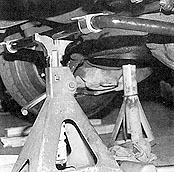
When both sides of the sway bar have been installed onto
the end links, use a spare jack stand to support the sway bar near where
it will eventually be mounted to the frame.
|
|
| Classic Performance Products 378 E Orangethorpe
Ave., Placentia CA 92870 Tech Line 714-522-2000 |
 |
TECH
| BOOKS | SUSPENSION
| BRAKES | STEERING | CONTACT
US | HOT PRODUCTS |

|
| © Classic Performance Products. This "website"
and all contents are property of Classic Performance Products.
Prices subject to change without notice. Not responsible for
errors or omissions. Please note that kits & prices
may vary between certain applications. |
|
|
|
|
|
|
|